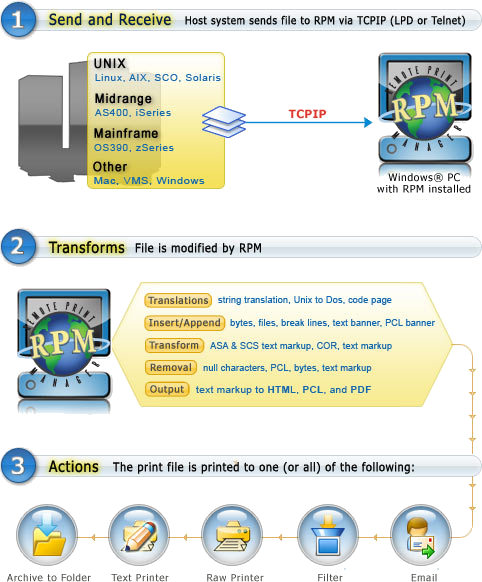HP3000 Network Printing with RPM Remote Print Manager® (RPM) supports receiving jobs via the Telnet printing protocol, also known as "stream printing" or "reverse telnet." RPM offers HP remote printing features not often found in mainframe-to-PC printing. The ability to customize and control the processing of print jobs over a TCP/IP network is what sets RPM apart from any other print server.

- RPM will remove PCL codes automatically with no need to reconfigure the application.
- RPM will format ANY text file and print to ANY Windows printer, regardless of paper size, tray selection, # of copies, paper orientation, or printer destination.
- RPM eliminates the need to purchase 3rd-party LPR/LPD print spoolers for HP3000. RPM can receive data directly from the HP3000 using the native TCP/IP printing supported by MPE/iX.
- RPM allows easy "Print-to-File" (Write-to-Disk) capabilities.
- Setting Up Remote Printer on HP9000.
Benefits of using RPM with the HP3000 MPE/iX Operating System
The HP3000 supports only printers that understand the PJL and PCL printing languages.
- RPM provides the ability to print jobs from MPE/iX to any printer, regardless of brand name, with no need to purchase HP-specific equipment.
- Manipulate print convert PCL to PDF while lowering printing costs (manipulate and convert PCL to PDF case study)
Network printers are typically required when sharing a single printer between Windows clients and HP3000 servers. RPM eliminates this requirement by printing directly to any printer on your Windows network. RPM supports locally connected printers, shared printers, and printers connected directly to the network via standard print protocols.
RPM Feature-packed Printing Queues
Within RPM print queues, a user will set up transforms and actions, each performing a different task with the print file. Understanding RPM's Printing Queues is the key to getting the most value from using RPM.
- RPM gives users the ability to control fonts with dynamic sizing using lines-per-inch and characters-per-inch and to set page margins. Any text data stream can be formatted for a Windows printer whether MPE/iX supports the printer or not!
- Within RPM's Filter printing, the print job is captured to process with an application.
- RPM archives to a folder, either local or shared. RPM checks for duplicate filenames before saving and has many file naming options. RPM can be configured to open print data in other applications such as word processors, spreadsheets, or other programs.
- RPM will pass raw information from the HP3000 to the PC print queue bypassing the Windows print driver. RPM processes print data without modification as if the printer were connected directly to the host system through a parallel or serial connection. RPM's standard processing supports sending data unmodified as well as appending, removing, string translations, input tray setting, and more.